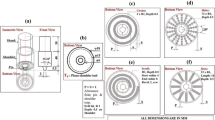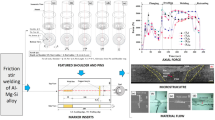Abstract
In the present study, the tool shoulder end features such as concentric circle shoulder tool (TCC), ridge shoulder tool (TR), knurling shoulder tool (TK), and scroll shoulder tool (TS) were designed, and their effect on weld size, vertical force, temperature distribution, and material flow was investigated during friction stir welding (FSW) of Al-Mg-Si alloy. The vertical force, tool torque, and temperature during the welds were measured and compared for all the tools. The deformed marker material was used to analyze the material flow caused by the shoulder and pin. The experimental results show that the welds with shoulder end featured tools of smaller shoulder diameter (ϕ18mm)were comparable with the welds with plane shoulder tool (TP) of larger shoulder diameter (ϕ21mm) in the aspects of temperature and weld strength with reduced weld size. At initial stage, the plasticized material, beneath the tool shoulder, moves from advancing side (AS) to retreating side (RS) whereas the material around the pin moves from RS to AS. Overall, the welds produced with the proposed tool shoulder end features achieved lower vertical force, higher temperature, and minimum/no flash compared to TP of equal/higher shoulder diameter. The welds produced with TR resulted in better mechanical properties with lower vertical force, i.e., approximately 36% than that of (TP)21 tool and the hardness of weld zone is at a value of 65–78 HV0.1.
Similar content being viewed by others
References
Nandan R, Debroy T, Bhadeshia H (2008) Recent advances in friction-stir welding – process, weldment structure and properties. Prog Mater Sci 53:980–1023. https://doi.org/10.1016/j.pmatsci.2008.05.001
Schmidt H, Hattel J, Wert J (2004) An analytical model for the heat generation in friction stir welding. Model Simul Mater Sci Eng 12:143–157. https://doi.org/10.1088/0965-0393/12/1/013
Schmidt H, Hattel J (2005) Modelling heat flow around tool probe in friction stir welding. Sci Technol Weld Join 10:176–186. https://doi.org/10.1179/174329305X36070
Asadi P, Mahdavinejad RA, Tutunchilar S (2011) Simulation and experimental investigation of FSP of AZ91 magnesium alloy. Mater Sci Eng A 528:6469–6477. https://doi.org/10.1016/j.msea.2011.05.035
Assidi M, Fourment L, Guerdoux S, Nelson T (2010) Friction model for friction stir welding process simulation: calibrations from welding experiments. Int J Mach Tools Manuf 50:143–155. https://doi.org/10.1016/j.ijmachtools.2009.11.008
Huang Y, Wang Y, Wan L, Liu H, Shen J, Dos Santos JF, Zhou L, Feng J (2016) Material-flow behavior during friction-stir welding of 6082-T6 aluminum alloy. Int J Adv Manuf Technol 87(1–9):1115–1123. https://doi.org/10.1007/s00170-016-8603-7
Kumar K, Kailas SV (2008) The role of friction stir welding tool on material flow and weld formation. Mater Sci Eng A 485:367–374. https://doi.org/10.1016/j.msea.2007.08.013
Zhang YN, Cao X, Larose S, Wanjara P (2012) Review of tools for friction stir welding and processing. Can Metall Q 51:250–261. https://doi.org/10.1179/1879139512Y.0000000015
Galvao I, Leal RM, Rodrigues DM, Loureiro A (2013) Influence of tool shoulder geometry on properties of friction stir welds in thin copper sheets. J Mater Process Technol 213:129–135. https://doi.org/10.1016/j.jmatprotec.2012.09.016
Cederqvist L, Sorensen CD, Reynolds AP, Oberg T (2009) Improved process stability during friction stir welding of 5 cm thick copper canisters through shoulder geometry and parameter studies. Sci Technol Weld Join 14:178–184. https://doi.org/10.1179/136217109X400420
Scialpi A, De Filippis LAC, Cavaliere P (2007) Influence of shoulder geometry on microstructure and mechanical properties of friction stir welded 6082 aluminium alloy. Mater Des 28:1124–1129. https://doi.org/10.1016/j.matdes.2006.01.031
De Giorgi M, Scialpi A, Panella FW, De Filippis LAC (2009) Effect of shoulder geometry on residual stress and fatigue properties of AA6082 FSW joints. J Mech Sci Technol 23:26–35. https://doi.org/10.1007/s12206-008-1006-4
Leal RM, Leitao C, Loureiro A, Rodrigues DM, Vilaca P (2008) Material flow in heterogeneous friction stir welding of thin aluminium sheets: effect of shoulder geometry. Mater Sci Eng A 498:384–391. https://doi.org/10.1016/j.msea.2008.08.018
Trueba L, Heredia G, Rybicki D, Johannes LB (2015) Effect of tool shoulder features on defects and tensile properties of friction stir welded aluminum 6061-T6. J Mater Process Technol 219:271–277. https://doi.org/10.1016/j.jmatprotec.2014.12.027
Trimble D, O’Donnell GE, Monaghan J (2015) Characterisation of tool shape and rotational speed for increased speed during friction stir welding of AA2024-T3. J Manuf Process 17:141–150. https://doi.org/10.1016/j.jmapro.2014.08.007
Seidel TU, Reynolds AP (2001) Visualization of the material flow in AA2195 friction-stir welds using a marker insert technique. Metall Mater Trans A 32:2879–2884. https://doi.org/10.1007/s11661-001-1038-1
Reynolds AP (2000) Visualisation of material flow in autogenous friction stir welds. Sci Technol Weld Join 5:120–124. https://doi.org/10.1179/136217100101538119
Zhang Z, Liu YL, Chen JT (2009) Effect of shoulder size on the temperature rise and the material deformation in friction stir welding. Int J Adv Manuf Technol 45:889–895. https://doi.org/10.1007/s00170-009-2034-7
Pashazadeh H, Teimournezhad J, Masoumi A (2017) Experimental investigation on material flow and mechanical properties in friction stir welding of copper sheets. Int J Adv Manuf Technol 88:1961–1970. https://doi.org/10.1007/s00170-016-8913-9
Li H, Qin W, Liu D, Li Q, Wu Y (2017) Design of friction stir welding tools reducing heat flow into spindle. Int J Adv Manuf Technol 94(1–8):1925–1932. https://doi.org/10.1007/s00170-017-0985-7
Mugada KK, Adepu K (2018) Role of tool shoulder end features on friction stir weld characteristics of 6082 aluminum alloy. J Inst Eng Ser C. https://doi.org/10.1007/s40032-018-0451-9
Mugada KK, Adepu K (2018) In fl uence of ridges shoulder with polygonal pins on material fl ow and friction stir weld characteristics of 6082 aluminum alloy. J Manuf Process 32:625–634. https://doi.org/10.1016/j.jmapro.2018.03.034
Thomas WM, Nicholas ED, Smith SD (2001) Friction stir welding-tool deelopments, Proc. Aluminum automotive and Joining Sessions. TMS, Warrendale, pp 213–224
Xiong JT, Zhang XC, Li P, Qian JW, Li JL, Zhang FS, Dong HB (2014) Characterisation of periodic variation in torque occurred in friction stir welding process. Sci Technol Weld Join 19:350–354. https://doi.org/10.1179/1362171814Y.0000000195
Ilangovan M, Rajendra Boopathy S, Balasubramanian V (2015) Effect of tool pin profile on microstructure and tensile properties of friction stir welded dissimilar AA 6061–AA 5086 aluminium alloy joints. Def Technol 11:174–184. https://doi.org/10.1016/j.dt.2015.01.004
Al-Fadhalah KJ, Almazrouee AI, Aloraier AS (2014) Microstructure and mechanical properties of multi-pass friction stir processed aluminum alloy 6063. Mater Des 53:550–560. https://doi.org/10.1016/j.matdes.2013.07.062
Acknowledgements
The authors are thankful to The Department of Mechanical Engineering, National Institute of Technology Warangal for providing facilities to carry out this work.
Author information
Authors and Affiliations
Corresponding author
Rights and permissions
About this article
Cite this article
Mugada, K.K., Adepu, K. Influence of tool shoulder end features on friction stir weld characteristics of Al-Mg-Si alloy. Int J Adv Manuf Technol 99, 1553–1566 (2018). https://doi.org/10.1007/s00170-018-2602-9
Received:
Accepted:
Published:
Issue Date:
DOI: https://doi.org/10.1007/s00170-018-2602-9




